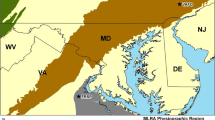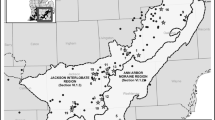Abstract
Estimates of number of wetlands derived from quadrat sampling are inherently biased when wetlands on quadrat boundaries are counted. Bias complicates comparisons of wetland density or abundance between years or studies, or between regions with different wetland sizes. Simulated quadrat sampling was conducted to evaluate the magnitude of bias in estimates of the number of temporary, seasonal, semipermanent, and total wetlands from samples of square quadrats of different sizes. All estimates were biased except for number of temporary wetlands derived from samples of the largest quadrats. Bias ranged from +101% (SE=0.39%) for estimates of the number of semipermanent wetlands sampled with 0.64 km2 quadrats to +0.19% (SE=0.19%) for the number of temporary wetlands sampled with 25.60 km2 quadrats. Bias was greatest when large wetlands were sampled using small quadrats and was related to quadrat perimeter: area ratio (km/km2) and to quadrat size. Managers and researchers should correct for bias in estimates of number of wetlands by deriving correction factors with the equations presented or by deriving correction factors using aerial photographs to determine the geometric centers of wetlands in and around a subset of sample quadrats.
Similar content being viewed by others
Literature Cited
Besag, J. and J. T. Gleaves. 1973. On the detection of spatial patterns in plant communities. Bulletin of the International Statistical Institute 45:153–158.
Brewster, W. G., J. M. Gates, and L. D. Flake. 1976. Breeding waterfowl populations and their distribution in South Dakota. Journal of Wildlife Management 40:50–59.
Cowardin, L. M. 1982. Some conceptual and semantic problems in wetland classification and inventory. Wildlife Society Bulletin 10:57–60.
Cowardin, L. M., D. S. Gilmer, and C. W. Shaiffer. 1985. Mallard recruitment in the agricultural environment of North Dakota. Wildlife Monogrphs 92.
Cowardin, L. M., D. S. Gilmer, and L. M. Mechlin. 1981. Characteristics of central North Dakota Wetlands determined from sample aerial photographs and ground study. Wildlife Society Bulletin 9:280–288.
Cowardin, L. M., D. H. Johnson, A. M. Frank, and A. T. Klett. 1983. Simulating results of management actions on mallard productivity. Transactions of the North American Wildlife and Natural Resources Conference 48:257–272.
Cowardin, L. M., T. L. Shaffer. and P. M. Arnold. 1995. Evaluation of duck habitat and estimation of duck population sizes with a remote-sensing-based system. National Biological Service, Washington, DC, USA. Biological Science Report No. 2.
Diggle, P. J. 1975. Robust density estimation using distance methods. Biometrika 62:39–48.
Hammack, J. and G. M. Brown, Jr. 1974. Waterfowl and wetlands: toward bioeconomic analysis. Resources for the Future, Inc., Washington, DC, USA.
Johnson, D. H. and J. W. Grier. 1988. Determinants of breeding distributions of ducks. Wildlife Monographs 100.
Johnson, R. R., and K. F. Higgins. 1997. Wetland Resources of Eastern South Dakota. South Dakota State University, Brookings, SD, USA.
Krebs, C. J. 1989. Ecological Methodology. Harper Collins Publishers, New York, NY, USA.
Martin, F. W., R. S. Pospahala, and J. D. Nichols. 1979. Assessment and population management of North American migratory birds. p. 187–239.In J. Cairns, Jr., G. P. Patil, and W. E. Waters (eds.) Environmental Biomonitoring. Assessment, Prediction, and Management—Certain Case Studies and Related Quantitative Issues. International Cooperative Publishing House, Fairland, MD, USA.
Ruwaldt, J. J., Jr., L. D. Flake, and J. M. Gates. 1979. Waterfowl use of natural and man-made wetlands in South Dakota. Journal of Wildlife Management 43:375–383.
SAS Institute, Inc. 1989. SAS/STAT User’s Guide, Version 6. Fourth ed. SAS Institute, Inc., Cary, NC, USA.
Sugden, L. G. and G. Butler. 1980. Estimating densities of breeding canvasbacks and redheads. Journal of Wildlife Management 44:814–821.
U.S. Fish and Wildlife Service and Canadian Wildlife Service. 1987. Standard operating procedures for waterfowl population and habitat surveys in North America. U.S. Fish and Wildlife Service and Canadian Wildlife Service, Office of Migratory Bird Management, Laurel, MD, USA.
Weigert, R. G. 1962. The selection of an optimal quadrat size for sampling the standing crop of grasses and forbs, Ecology 43:125–129.
Author information
Authors and Affiliations
Rights and permissions
About this article
Cite this article
Johnson, R.R., Higgins, K.F. Bias in quadrat-derived estimates of number of prairie wetlands. Wetlands 18, 329–334 (1998). https://doi.org/10.1007/BF03161528
Received:
Revised:
Accepted:
Issue Date:
DOI: https://doi.org/10.1007/BF03161528




